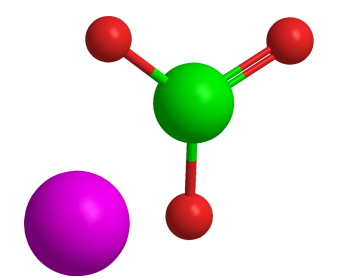What molecule am I?


Perovskite is a mineral that consists of calcium titanate (CaTiO3), also known as calcium titanium oxide. CaTiO3 is colorless, but perovskite takes on the colors of various impurities, such as iron and copper. The mineral occurs as orthorhombic crystals.
University of Berlin mineralogist Gustavus Rose discovered perovskite in the Ural Mountains of Russia in 1839. He named the substance after Russian mineralogist and nobleman Lev Perovski.
The name “perovskite” is also used broadly for compounds with the structure ABX3, in which A is a metal with oxidation state 2+; B is a metal with oxidation state 4+; and X is a nonmetal, usually oxygen, with oxidation state 2–. Minerals composed of these compounds are likewise called perovskites.
Perovskite, along with the minerals rutile and ilmenite, is valuable as a titanium ore. In addition to Russia, it occurs in such diverse locations as Switzerland, Italy, and Arkansas.
Many oxides with the perovskite structure have physical and chemical properties that make them useful in electronic devices. Their characteristics include electrical conductivity; oxide ion mobility through crystal lattices; thermal and chemical stability; and supermagnetic, photocatalytic, thermoelectric, and dielectric properties. CaTiO3 in particular exhibits strong electrical and ionic conductivity.
Perovskite hazard information
| Hazard class* | Hazard statement |
|---|---|
| Not a hazardous substance or mixture |
*Globally Harmonized System of Classification and Labeling of Chemicals.
MOTW update: June 27, 2022
The mineral perovskite is calcium titanate (CaTiO3), but many inorganic compounds with the structure ABX3 are also called perovskites. These substances have several uses, including photovoltaics in solar cells. This month, Lijun Zhang at Jilin University (Changchun, China), Hairen Tan at Nanking University (China), and their colleagues announced a record for the certified energy conversion efficiency of perovskites in flexible thin-film photovoltaics: 24.4%, compared with the previous record of 19.9%.
This molecule was suggested by a reader. We present almost all of the molecules suggested by our readers. If you have a molecule you would like us to consider, please send us a message. And thank you for your interest in Molecule of the Week! —Ed.
Perovskite fast facts
| CAS Reg. No. | 12194-71-7 |
| SciFinder nomenclature | Perovskite [Ca(TiO3)] |
| Empirical formula | CaO3Ti |
| Molar mass | 135.94 g/mol |
| Appearance | Black, brown, yellow, or orange crystals |
| Melting point | 1975 ºC |
| Water solubility | Insoluble |
Over the years, readers have noted that ionic substances are not actually molecules. This is correct, but we use "molecules" in the broadest sense to include them in Molecule of the Week.—Ed.

Learn more about this molecule from CAS, the most authoritative and comprehensive source for chemical information.
Molecule of the Week needs your suggestions!
If your favorite molecule is not in our archive, please send us a message. The molecule can be notable for its current or historical importance or for any quirky reason. Thank you!
Stay Ahead of the Chemistry Curve
Learn how ACS can help you stay ahead in the world of chemistry.

